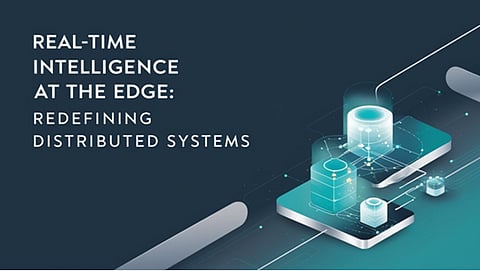

The fusion of AI and edge computing is reshaping how systems process data and make decisions in real time. Traditional computing models are buckling under the surge of real-time data, creating the need for localized processing. Amit Kumar, a technology researcher focused on decentralized intelligence, explores how shifting computation from centralized data centers to the edge empowers systems to operate autonomously and respond instantly. This convergence minimizes latency, reduces cloud dependency, and enables intelligent decision-making at the source. The result is a more agile, resilient infrastructure capable of thriving in data-intensive environments. These advancements signal a pivotal shift in the way networks manage and apply intelligence.
The harmony of edge computing and AI evolves through three fundamental architectural models: hierarchical, hybrid, and fully distributed. Fully distributed architectures use light models such as MobileNetV3 on edge devices themselves, providing ultra-low-latency inference without cloud connectivity. Hybrid architectures, like Distributed Deep Neural Networks (DDNN), find a balance by dynamically distributing workloads between edge and cloud layers. Conversely, hierarchical models place layers between edge and cloud, making a cascading hierarchy of processing tasks that change in response to shifting bandwidth and latency levels. Each model finds a distinct purpose. Isolated environments are served best by fully distributed configurations, hybrids shine where networks vary, and hierarchical frameworks provide scalable tiered processing. Implementation of such designs makes systems more resilient, responsive, and resource-frugal.
Handling the flood of data generated by edge environments requires innovative methods for processing. Stream processing enables devices to process continuous data streams in real-time, minimizing latency on decisions and power consumption. This is particularly important in industrial contexts, where real-time responsiveness can avoid expensive downtimes and operational risk.
Filtering and prioritization also take center stage. Through smart filtering at source, systems deliver only the most critical data to upper layers, conserving bandwidth pressure while holding onto precision. Moreover, distributed learning models are now executed locally on devices, using a minimal amount of memory but retaining high detection accuracy—the critical step needed for environments of limited connectivity or power.
One of the most straightforward examples of collaboration between AI-edge is in real-time responsiveness. Autonomous navigation and industrial automation applications require millisecond decisions. Edge-optimized models like YOLOv3 provide frame processing rates that enable vehicles to spot obstacles in a split second, avoiding the cloud-based system's latency.
Likewise, intelligent manufacturing environments are combining AI at the edge to forecast equipment failures with high certainty hours beforehand. This anticipation reduces downtime and optimizes operational continuity. In medicine, wearable technology now uses small neural networks to track vital signs and identify anomalies in real time without ever having to go to the cloud. The outcome is quick, trustworthy, and localized decision-making that can be the difference between proactive action and reactive failure.
Decentralization brings new risks. Edge devices, by their nature more vulnerable to physical tampering and less powerful computationally, demand security solutions built for their limitations. Lightweight encryption algorithms such as PRESENT and SIMON offer better power and memory efficiency than traditional standards and allow secure handling of data on modest hardware.
Privacy-protecting machine learning algorithms further guarantee confidentiality of data, even in collaborative training. Such approaches safeguard individual contributions to data while ensuring model functionality. In parallel, blockchain identity systems are transforming device verification with greatly lowered verification time and energy consumption as well as heightened breach resilience. All together, all these layered defences create a strong security scaffold that is specific to edge environments.
The union of edge computing and AI is not simply a tech wave, it's a transformation in the way, where, and when intelligence plays in our digital landscapes. It's a model that distributes itself, decentralizes decision-making so that systems not only react, but are intelligent ahead of time. Whether used to power autos, factories, or medical gear, this mode of thinking produces the performance, robustness, and responsiveness the world needs, now more intertwined than ever before. It enables systems that are nearby to adjust at the moment conditions change without help from remote servers. Therefore, innovation happens rapidly at the edge where speed and autonomy are absolutely important.
In conclusion, Amit Kumar’s insights illuminate a future where edge devices evolve beyond passive endpoints into intelligent, autonomous agents. These nodes operate independently, making real-time decisions at the data source. The result is a smarter, safer, and more responsive infrastructure. This shift redefines how intelligence is distributed across networks. It marks a significant step toward a truly decentralized digital ecosystem. As edge capabilities continue to mature, their impact will extend across industries and everyday life.
